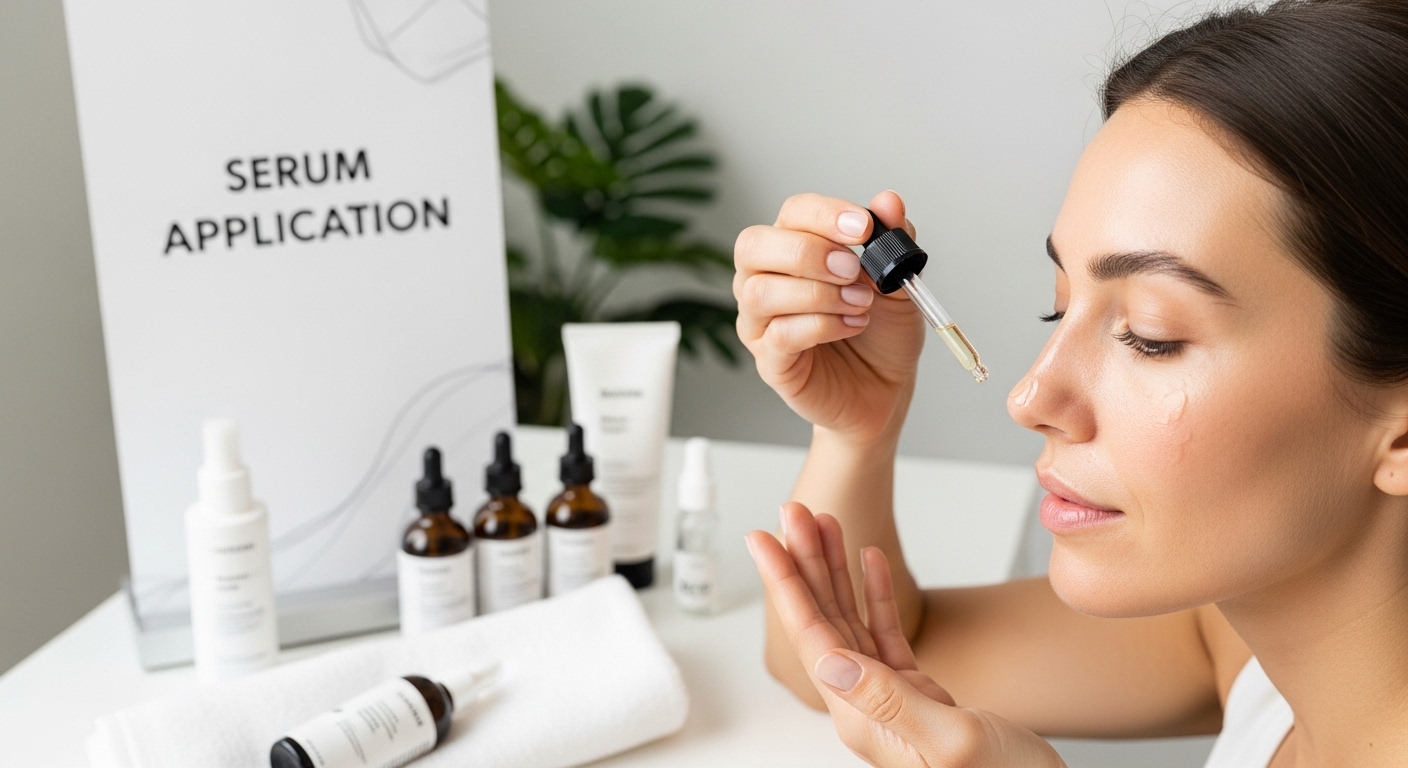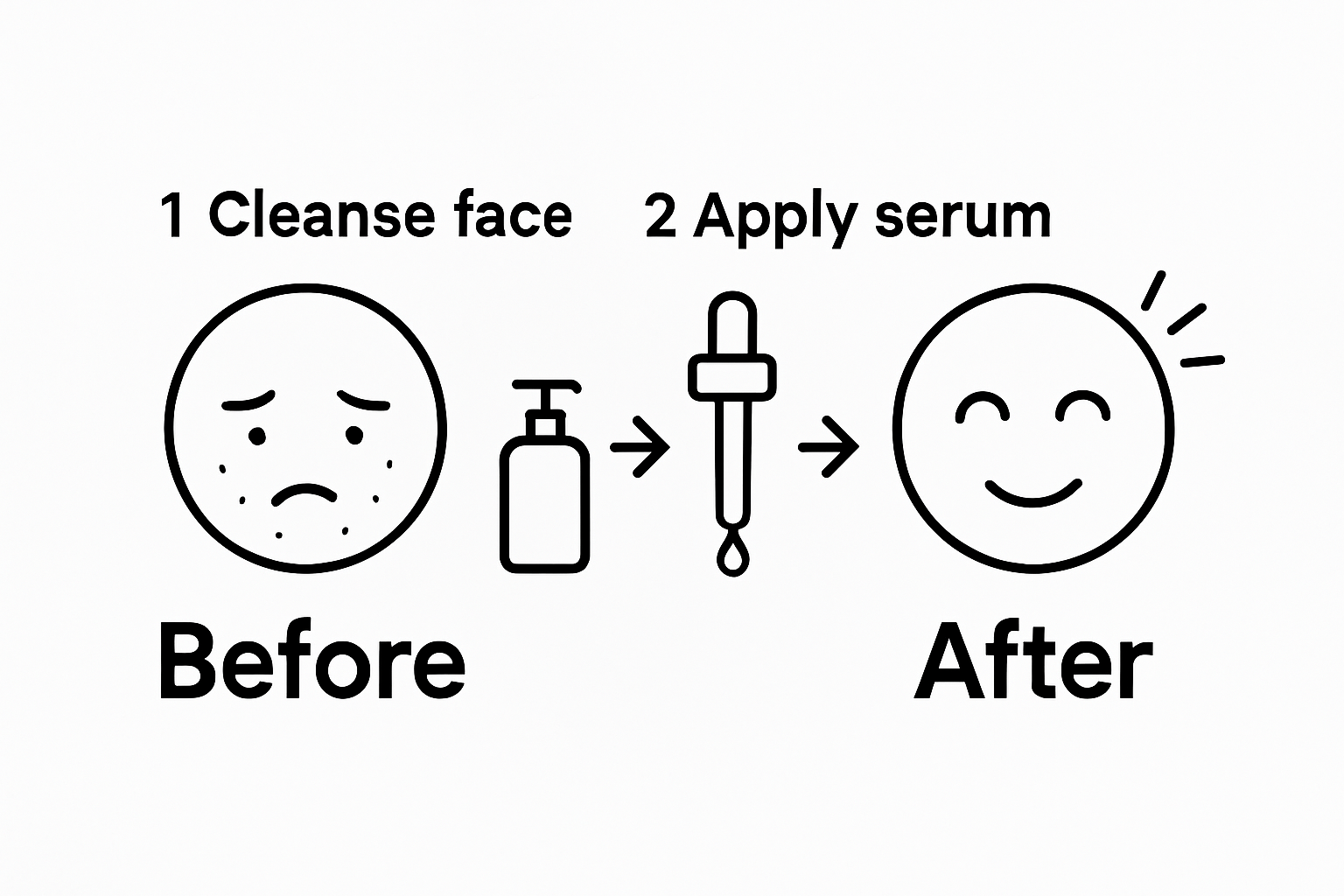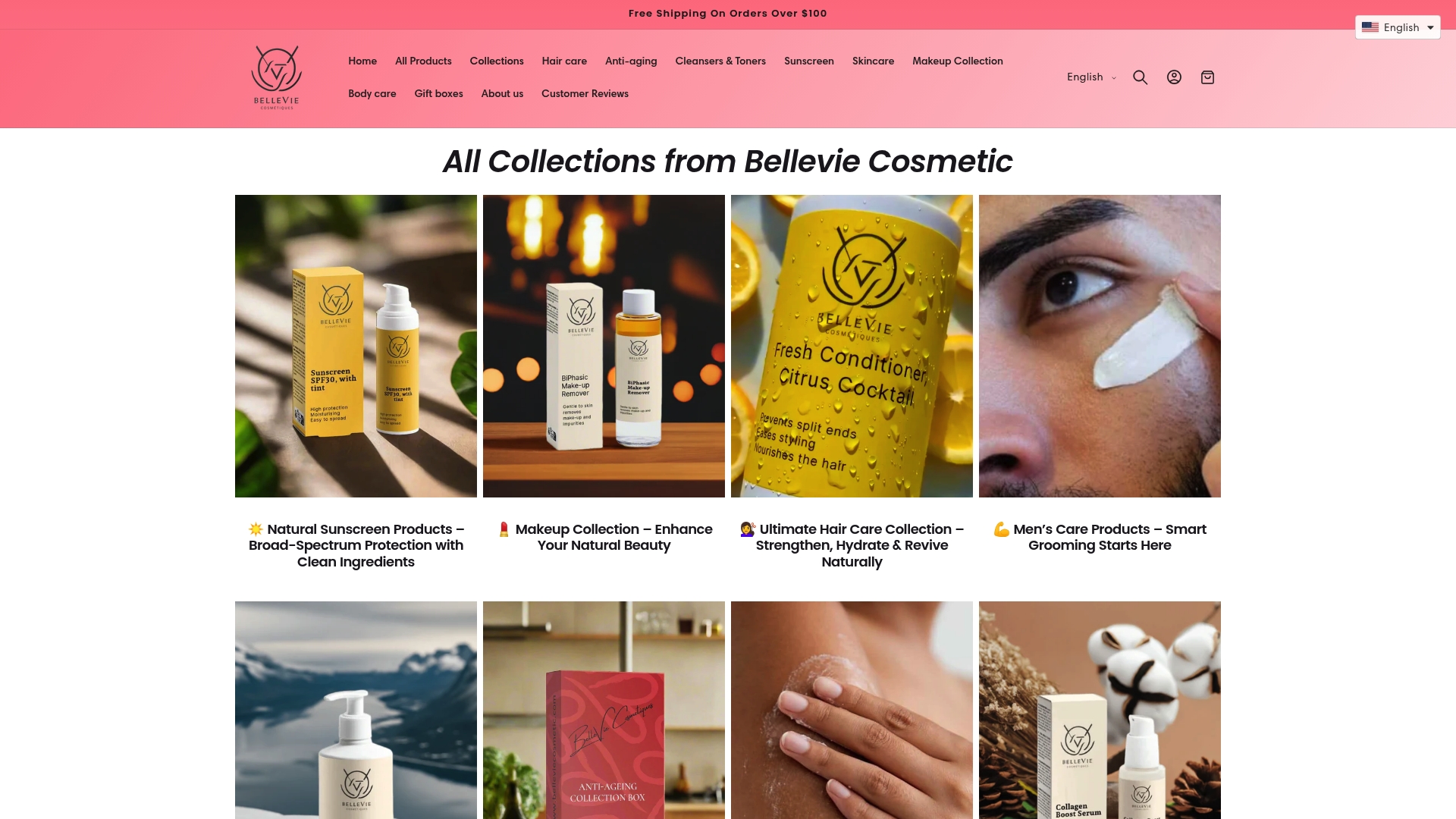Building the perfect serum routine starts with knowing your own skin. Most people skip the step where you actually analyze your skin type by looking for texture, oil, and hydration clues in natural daylight. Sounds simple, but almost everyone gets it wrong. What really unlocks results is treating your face like a science project with a full assessment and real tracking, not just guessing based on how you feel.
Table of Contents
- Step 1: Analyze Your Skin Type And Needs
- Step 2: Select The Right Serums For Your Goals
- Step 3: Prepare Your Skin For Serum Application
- Step 4: Apply Serums In The Correct Order
- Step 5: Test And Adjust Your Routine For Optimal Results
Quick Summary
| Key Point | Explanation |
|---|---|
| 1. Analyze Your Skin Type First | Understanding your unique skin profile is crucial for selecting effective serums tailored to your specific skin needs. |
| 2. Choose Targeted Serum Ingredients | Match serum ingredients to your skincare goals, such as hydration, anti-aging, or acne treatment for maximum efficacy. |
| 3. Prepare Your Skin Properly | Clean and gently dry your skin before application to enhance serum absorption and effectiveness. |
| 4. Apply Serums in Correct Order | Use a systematic layering approach, applying from thinnest to thickest formulations for optimal penetration. |
| 5. Test and Adjust Regularly | Monitor skin reactions to introduced serums over time to refine your routine for the best results. |
Step 1: Analyze Your Skin Type and Needs
Understanding your unique skin profile is the foundational step in creating a personalized serum strategy that delivers transformative results. Before introducing any new skincare products, you need a comprehensive assessment that goes beyond surface-level observations.
Begin by examining your skin closely in natural daylight, looking for key characteristics that define your specific skin type. Observe texture, hydration levels, oil production, and sensitivity indicators. Are you experiencing persistent dryness, occasional breakouts, uneven tone, or early signs of aging? These visual and tactile cues provide critical insights into your skin’s underlying needs.
Below is a table that summarizes the main skin types, their key characteristics, and typical indicators, helping readers identify their own skin profile at a glance.
| Skin Type | Key Characteristics | Typical Indicators |
|---|---|---|
| Dry Skin | Tight, dull appearance, fine lines | Flakiness, rough texture, increased sensitivity |
| Oily Skin | Shiny, enlarged pores, prone to breakouts | Greasy T-zone, frequent blemishes or blackheads |
| Combination Skin | Varies by facial zone, mix of oily and dry areas | Oily T-zone with dry or normal cheeks |
| Sensitive Skin | Reacts quickly, easily irritated | Redness, stinging, inflammation upon product use |
To conduct a thorough skin analysis, perform a simple at-home assessment using clean hands and good lighting. Cleanse your face thoroughly and wait approximately one hour without applying any products. During this time, your skin will reveal its natural state. Check for shine in the T-zone (forehead, nose, chin), assess skin elasticity by gently pinching your cheek, and note any areas of redness, flakiness, or congestion.
Resetting Your Skincare Routine: The Complete 2025 Guide offers additional insights into understanding your skin’s unique characteristics. Focus on identifying whether your skin falls into these primary categories:
- Dry Skin: Feels tight, appears dull, shows fine lines more prominently
- Oily Skin: Appears shiny, prone to enlarged pores and occasional breakouts
- Combination Skin: Exhibits different characteristics in different facial zones
- Sensitive Skin: Reacts quickly to new products with redness or irritation
Consider additional factors like age, environmental exposure, hormonal changes, and existing skin conditions. These variables significantly influence how your skin will respond to different serum formulations. Consulting with a dermatologist can provide an even more precise evaluation, especially if you have persistent skin concerns or complex skin health challenges.
By meticulously analyzing your skin type and specific needs, you create a targeted approach that ensures your serum selection will be both effective and nurturing. This foundational step transforms skincare from a generic routine into a personalized skin transformation journey.
Step 2: Select the Right Serums for Your Goals
Choosing the perfect serum is akin to selecting a precision instrument for your skin’s unique transformation journey. After understanding your skin type, the next critical step involves matching targeted ingredients to your specific skincare objectives. Your serum selection should address individual concerns with surgical precision.
Approach serum shopping as a strategic mission, focusing on powerful active ingredients that align with your skin’s needs. If combating early signs of aging is your primary goal, seek serums containing peptides, bakuchiol (a natural retinol alternative), and hyaluronic acid. For individuals battling persistent acne or uneven texture, niacinamide and salicylic acid become your primary allies. Hydration enthusiasts should prioritize serums rich in glycerin, ceramides, and multi-molecular weight hyaluronic acid.
The Real Importance of Facial Serums: 2025 Guide to Younger, Healthier provides additional insights into ingredient selection. When evaluating potential serums, consider these critical evaluation criteria:
- Concentration of Active Ingredients: Higher percentages typically indicate more potent formulations
- Complementary Ingredient Combinations: Look for synergistic blends that enhance overall efficacy
- Skin Compatibility: Ensure ingredients won’t trigger sensitivity or adverse reactions
Understand that layering multiple serums requires strategic thinking. Start with the thinnest, most active formulation and progress to richer textures. A typical sequence might involve applying a lightweight vitamin C serum first, followed by a more substantial hyaluronic acid or peptide serum. This approach maximizes absorption and minimizes potential interaction issues between different active components.
Remember that your skin’s response is the ultimate validation. Patch test new serums, introduce them gradually, and observe how your skin reacts over two to four weeks. Signs of successful serum integration include improved texture, enhanced radiance, reduced visible concerns, and a balanced, healthy complexion. Patience and consistent observation are key to discovering your skin’s perfect serum match.
The following table highlights common serum ingredients, their main skin benefits, and the targeted goals they help you achieve, streamlining your ingredient selection process.
| Ingredient | Main Benefit | Best For |
|---|---|---|
| Peptides | Enhances skin elasticity | Anti-aging |
| Bakuchiol | Natural retinol alternative | Reducing fine lines |
| Hyaluronic Acid | Deep hydration, plumps skin | Dry/dehydrated skin |
| Niacinamide | Refines texture, balances oil | Acne-prone/uneven skin |
| Salicylic Acid | Clears pores, tackles breakouts | Oily/acne-prone skin |
| Glycerin | Boosts moisture levels | Hydration |
| Ceramides | Restores skin barrier | Sensitive/compromised skin |
Step 3: Prepare Your Skin for Serum Application
Successful serum application begins long before the product touches your skin. Proper preparation transforms your skincare routine from a mundane task into a precise, results-driven ritual. Think of your skin as a canvas that requires meticulous priming to maximize the absorption and effectiveness of your carefully selected serums.
Start by creating an optimal environment for your skincare routine. Choose a clean, well-lit space with a comfortable temperature and minimal distractions. Wash your hands thoroughly to prevent introducing bacteria or dirt onto your freshly cleansed face. Use lukewarm water to cleanse your face, avoiding extreme temperatures that can shock or irritate your skin. Select a gentle cleanser that matches your skin type, working it into a soft lather and massaging in circular motions to remove impurities without stripping natural oils.
How to Layer Skincare Products for Visible Results in 2025 offers additional insights into creating the perfect skincare preparation routine. After cleansing, pat your skin dry with a clean, soft towel using gentle dabbing motions. Avoid rubbing, which can cause unnecessary friction and potential irritation. The key is to leave your skin slightly damp, creating the perfect moisture level for serum absorption.
Prepare your skincare tools and products in advance to create a smooth, uninterrupted application process. Gather your selected serums, ensuring they are at room temperature and free from any signs of separation or unusual odors. Consider these essential preparation steps:
- Temperature Control: Keep serums at room temperature for optimal consistency
- Clean Application Surface: Use a clean surface with good lighting
- Organize Products: Arrange serums in order of intended application
Perform a quick skin check before application. Look for any signs of irritation, new breakouts, or unusual skin conditions that might require you to modify your approach. If your skin appears particularly sensitive or inflamed, consider delaying serum application or consulting a dermatologist. Successful preparation is about creating the most receptive environment for your skincare products to work their magic. Your skin should feel clean, slightly damp, and ready to receive the targeted nutrients and active ingredients in your carefully selected serums.

Step 4: Apply Serums in the Correct Order
Mastering the art of serum application is like conducting a precise symphony where each ingredient plays a critical role in your skin’s transformation. The order of application can make or break your skincare routine’s effectiveness, determining how deeply ingredients penetrate and interact with your skin.
Begin with the lightest, most active serums that require direct skin contact for maximum absorption. Typically, water-based serums with concentrated active ingredients should be applied first. This means your vitamin C or hyaluronic acid serums take the lead. Use your fingertips to gently pat and press these serums into your skin, allowing them to absorb completely before introducing the next product. The key is to create a thin, even layer that disappears into your skin without excessive rubbing or dragging.
How to Layer Skincare Products for Visible Results in 2025 provides additional guidance on strategic product layering. As you progress through your serum application, transition from thinnest to thickest formulations. Lightweight, water-soluble serums create a foundation for richer, oil-based treatments. This approach ensures that each subsequent product can penetrate effectively without being blocked by heavier molecular structures.
Consider these critical guidelines for serum application sequence:
- Start with water-based, active ingredient serums
- Progress to oil-based or more concentrated treatments
- Allow 30-60 seconds between each serum layer
- Use gentle patting motions, not aggressive rubbing
Pay close attention to how your skin responds during application. A successful serum routine should feel comfortable, with products absorbing smoothly without causing irritation or excessive shininess. Your skin should appear hydrated and plump, with a subtle, healthy radiance.
 If you experience any stinging, redness, or discomfort, pause and reassess your product combination. Remember that even the most potent serums require a gentle, mindful approach. The goal is not to overwhelm your skin but to provide targeted, strategic nourishment that supports its natural healing and renewal processes.
If you experience any stinging, redness, or discomfort, pause and reassess your product combination. Remember that even the most potent serums require a gentle, mindful approach. The goal is not to overwhelm your skin but to provide targeted, strategic nourishment that supports its natural healing and renewal processes.
Step 5: Test and Adjust Your Routine for Optimal Results
Transforming your skincare routine is not a one-time event but an ongoing journey of discovery and refinement. Your skin is a living, dynamic system that constantly responds to internal and external changes, requiring a flexible and attentive approach to serum application.
Begin your testing phase by implementing a systematic observation method. Introduce new serums one at a time, allowing a minimum of two to three weeks for your skin to adapt and respond. Document your skin’s reaction meticulously in a dedicated skincare journal, noting subtle changes in texture, hydration, breakouts, sensitivity, and overall appearance. Photograph your skin under consistent lighting conditions every week to track visual transformations that might be less apparent in daily observations.
Resetting Your Skincare Routine: The Complete 2025 Guide offers additional strategies for monitoring skincare progress. Pay close attention to how your skin reacts during different times of the month, acknowledging that hormonal fluctuations can significantly impact product effectiveness. Some serums might perform differently during various stages of your menstrual cycle or in response to stress, diet, and environmental changes.
Consider these critical evaluation criteria during your testing phase:
- Track skin texture and evenness
- Monitor hydration levels and elasticity
- Note any unexpected reactions or sensitivities
- Assess overall skin radiance and health
Remember that patience is your greatest ally in this process. Signs of a successful serum routine include improved skin barrier function, reduced inflammation, more consistent hydration, and a natural, healthy glow. If you experience persistent irritation, redness, or unexpected breakouts, pause your routine and consult a dermatologist. Your skin’s response is the most critical feedback mechanism. Some serums might require gradual introduction, starting with alternate days or lower concentrations to allow your skin to build tolerance. Ultimately, the goal is not perfection but a personalized skincare approach that makes your skin feel nourished, protected, and radiant.
Ready to Personalize Your Serum Routine and Unlock Flawless Skin?
You have just learned how analyzing your skin, choosing the right serums for your needs, and following a proven application sequence can change your skincare results. But finding clean, potent, and truly effective skincare formulas is the next challenge. At BelleVieCosmetic, our curated collection of natural serums, cleansers, and hydrators is designed to help you conquer dryness, sensitivity, early aging or oily skin—all with gentle, clinically backed actives.
Explore our science-backed hydrating serums and peptide treatments and discover real solutions that fit every step of the flawless skin blueprint described in this article. Achieve a healthy, radiant complexion with certified clean formulas that never include harsh chemicals or fake claims.

Take the next step on your skincare journey. Visit BelleVieCosmetic.com to build your personalized serum routine now. Shop today for exclusive new customer benefits and experience the difference of pure European beauty crafted just for you.
Frequently Asked Questions
How do I determine my skin type before using serums?
To determine your skin type, observe key characteristics such as texture, hydration levels, oil production, and sensitivity indicators. Conduct an at-home assessment by cleansing your face, waiting an hour without applying products, and then noting areas of shine, dryness, or irritation. This analysis will help you choose the right serum formulations.
What ingredients should I look for in serums for aging skin?
For aging skin, seek serums that contain peptides, bakuchiol, and hyaluronic acid, as these ingredients help enhance skin elasticity, reduce the appearance of fine lines, and provide deep hydration.
How should I layer my serums for the best results?
Layer your serums from thinnest to thickest. Start with water-based serums, such as vitamin C or hyaluronic acid, and follow with richer formulations. Allow 30-60 seconds between applying each serum to maximize absorption and prevent interaction issues.
How long should I test a new serum before deciding if it works?
Introduce new serums one at a time and allow at least two to three weeks for your skin to adapt. Monitor your skin’s reaction, tracking changes in texture, hydration, and overall appearance in a skincare journal for the most accurate assessment.
💬 Not sure how to add serums into your 2025 skincare routine?
Chat directly with our AI Beauty Advisor on Instagram and get personalized serum tips tailored to your skin.
